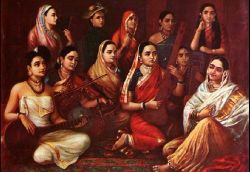Template: Featured article 12 6
From New World Encyclopedia
Revision as of 01:11, 6 July 2014 by Jennifer Tanabe (talk | contribs) (moved Template:Featured article 12 06 to Template:Featured article 12 6)
Featured Article: Sari
A sari or saree is the traditional female garment in India, Bangladesh, Nepal, and Sri Lanka. A sari is a very long strip of unstitched cloth, ranging from four to nine meters in length, which can be draped in various styles. The most common style is for the sari to be wrapped around the waist, with one end then draped over the shoulder baring the midriff. The history of Indian clothing traces the sari back to the Indus valley civilization, which flourished from 2800-1800 B.C.E. It is generally accepted that wrapped sari-like garments, shawls, and veils have been worn by Indian women in their current form for hundreds of years.
Saris are woven with one plain end (the end that is concealed inside the wrap), two long decorative borders running the length of the sari, and a one- to three- foot section at the other end which continues and elaborates the length-wise decoration. This end is called the pallu; it is the part thrown over the shoulder in the Nivi style of draping. In past times, all saris were hand woven of silk or cotton, and represented a considerable investment of time or money. Sometimes warp and weft threads were tie-dyed and then woven, creating ikat patterns, or threads of different colors were woven into the base fabric in patterns; an ornamented border, an elaborate pallu, and often, small repeated accents were woven in the cloth itself. For fancy saris, these patterns could be woven with gold or silver thread (zari work). Sometimes the saris were further decorated, after weaving, with various sorts of embroidery, pearls and precious stones. Modern saris are increasingly woven on mechanical looms and made of artificial fibers, but hand-woven saris are still popular for weddings and other grand social occasions.
